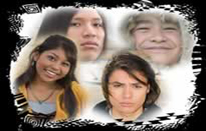Tribes Battle Meth Use on their own Terms
| Read More, Get Involved
|
When it came to major problems among Native populations, methamphetamine use ranked high on the list, due to the intense addictive nature of the drug, ease of creation and inexpensive price tag.
But abuse rates among Native Americans have exceeded national averages as tribes have been targeted by drug cartels, causing many tribes to go on the offense.
"Unfortunately meth is still a problem in our tribe and Wyoming as a whole," said Donovan Antelope, director of Northern Arapaho Public Relations Department.
The tribe has been targeted by drug cartels because of what Antelope says is a perceived weakness toward addiction. And in 2005 a drug ring was broken, costing the tribe some of their members who were involved.
 "It's very bad and it's scary that they would target us like that," Antelope said, but acknowledges that there is responsibility on everyone involved. "Many of our problems are we, as a tribe, are losing our culture so we're latching on to anything."
"It's very bad and it's scary that they would target us like that," Antelope said, but acknowledges that there is responsibility on everyone involved. "Many of our problems are we, as a tribe, are losing our culture so we're latching on to anything."
Now the goal is to keep children involved and bolster tribal members' appreciation for their history and culture through classes in their native language, a week-long language camp for young people to work on story telling, arts and crafts. Movie nights, ice skating and fishing derbies are offered for young people's evenings and weekends.
"It's tackling the problem of keeping kids occupied and making them proud of who they are and teaching them responsibility - that taking drugs is not glamorous," he said. "A lot of families are at the poverty level or below, so [parents] work two jobs and their attention is split, so a lot of the kids slip through the cracks."
To further engage children, Antelope said the tribe is looking to re-charter the Boys and Girls Club and has received four times the number of needed applications to start the process.
Long-range plans include building a drug recovery center and tying in cultural aspects, so people needing treatment will not have to travel away from family for help.
In Talihina, Okla., two treatment facilities serve men and mothers separately, but both utilize a ropes course through the program Natural High. The course, located in a pine tree forest, uses a series of cables and poles 30 to 50 feet high. Participants wear harnesses and safety gear as they attempt to climb poles, the rock wall and walk across a swinging log and a cable bridge with broken steps.
"Our Intertribal Council Methamphetamine Initiative (ICMI) project is focused around our ropes course; basically we use that as an enhancement for treatment," said Amanda Barron, ICMI project coordinator for the Choctaw Nation and case manager for Chi Hullo Li, the women's long-term care facility.
"It's not like treatment is not going to work without it, it's just a positive aspect to treatment," Barron said. "They're very intimidated by it because it's something that they feel they can't do, so when they do it, it's like a big accomplishment."
Chad Goggans, the challenge course coordinator readily admits his bias toward the program, but said he believes the skills used to navigate the course enhance the recovery process.
"I can really see the benefit in it," he said. "I can see the progress they've made in themselves. You can actually see the transformation. They drop the façade they show to people."
By attempting the course elements, Goggans said clients display their responses to stressful situations. While intertwining the goals of safety, fun and self growth, participants are "challenged by choice" or encouraged to participate on the course until completion.
"I tell them I don't care how far you go as long as you get outside your comfort zone," he said, adding that group members also give support and encouragement.
After working the course, clients retreat to a yurt to talk about their experiences on the course and how it relates to life and drug use.
"A lot of these people come from abusive relationships," Goggans said. "They're broken in a lot of places on the inside."
But through the ropes course, Goggans sees progress as clients push themselves to literally climb higher, leaving behind the issues that led to meth use on the ground below.
"You can see the confidence," he said. "You can see the trust. You can see the wonder at each step they take. Each step they take is a different experience, because it's outside of their comfort zone."
Fia Curley is a writer for the OMHRC. Comments? E-mail: fcurley@omhrc.gov
Know the Side Effects of Meth Use
Short term effectsIncrease physical activity
Decrease in appetite
Increase in body temperature
Long-term effects
Addiction
Paranoia
Hallucinations
Brain damage
Rage
Violent Behavior




